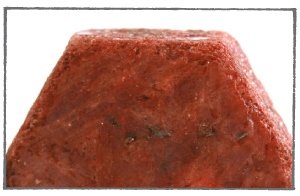RUBY

RUBY IS THE RED VARIETY of the mineral corundum. In general, only red corundum is considered ruby; when the gem becomes light enough to appear pink, it is called pink sapphire. However, where ruby ends and pink sapphire begins is often a matter of disagreement. To some, there is no pink sapphire, and all red corundum is ruby; others see a distinction between the rich red of ruby and the subtle, velvety shades of pink sapphire. Whatever the name, the color comes from trace elements of chromium. The presence of chromium also disrupts the crystal structure of corundum, and for this reason, fine rubies over 5 karats are exceedingly rare. The finest rubies have historically come from Burma, and early miners in this area believed that the paler colored stones had not yet fully matured into rubies. (A similar belief was held about pale green beryl and emeralds.) Other notable deposits occur in Sri Lanka, East Africa, Afghanistan, and Madagascar. Because of the rarity of fine ruby and the great demand, many poor-quality stones are treated in a variety of ways to achieve a salable appearance.
Rubies have enjoyed continued popularity through the ages, but no one revered them as much as the Burmese, who at the height of their glory owned and operated not only the largest ruby mines in history, but collections of cut stones that would have made the richest pharaoh quake with jealousy. The Burmese believed that a ruby made one invincible, and their warriors were known to insert the jewels under the surface of their skin before battles. The finest rubies in the world, such as the De Long Ruby, a 100.3-karat star ruby, and the Mandalay Ruby, a 48-karat faceted stone, are of Burmese origin. Rubies have been thought to ignite passion in lovers. In ancient Egypt, it was believed that if a woman wore a ruby against her skin, her life would be full of love and happiness. Throughout the Middle Ages, rubies were used medicinally to treat eye, liver, and blood diseases. Rubies, or lack thereof, have also been a major source of disappointment: two highly prized pieces of the English Crown Jewels (the collection of precious ceremonial objects used throughout history and belonging to the English monarchy) were, in fact, spinel. Ruby is the modern and ayurvedic birthstone for July and also the ayurvedic birthstone for December; it is associated with the fifteenth and fortieth wedding anniversaries and is linked to Capricorn and Taurus.